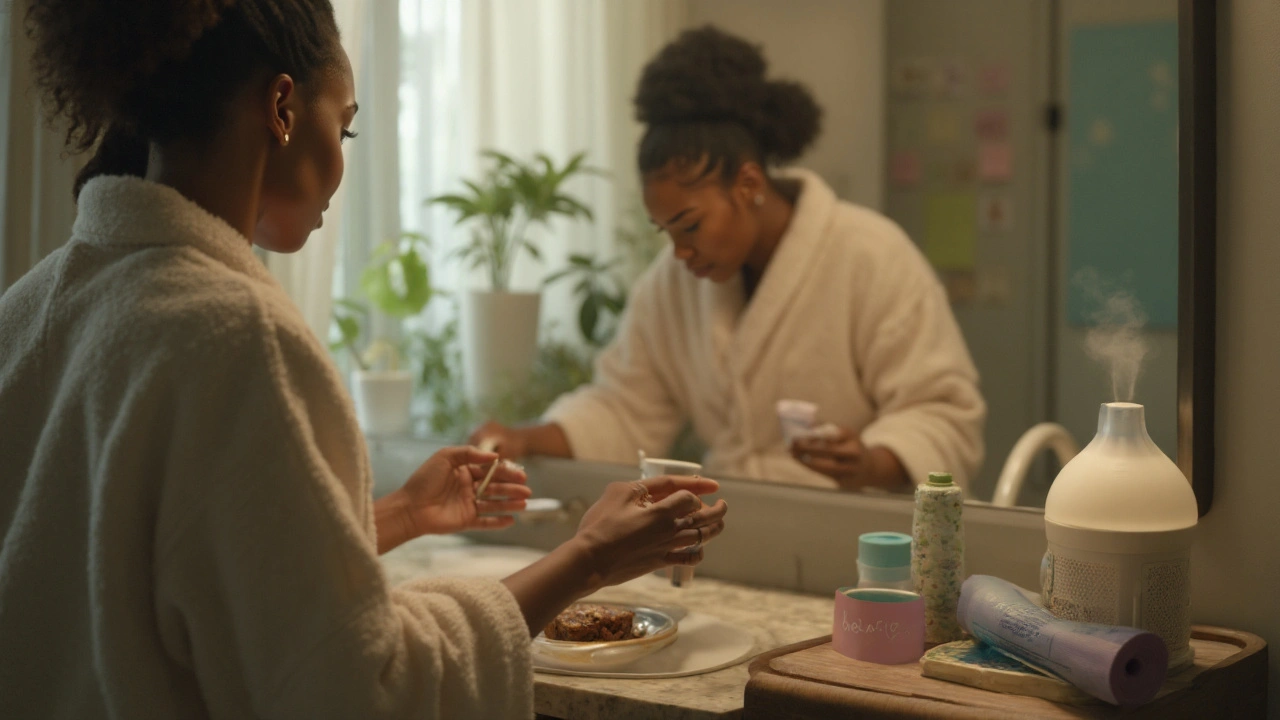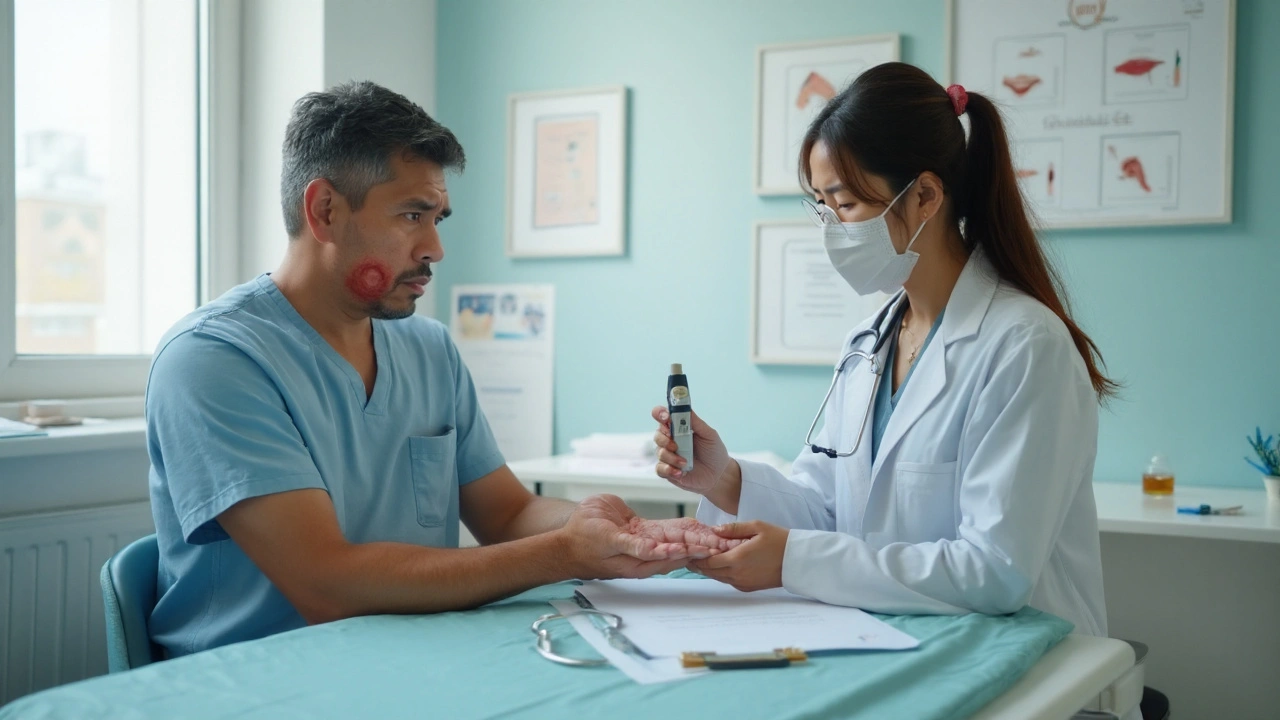You feel fine one minute, then a big meeting or family blow-up hits-and your face is blotchy, your scalp is itchy, or your acne goes wild. That’s not your imagination. Stress literally talks to your skin. This guide explains what’s going on under the surface, how to tell a stress flare from something else, what to do right now, and how to build a plan so your skin keeps its cool when life doesn’t. Expect simple steps, realistic timelines, and zero fluff.
- TL;DR / Key takeaways
- Stress can trigger or worsen acne, eczema, hives, psoriasis, seborrheic dermatitis, and rosacea through hormones and inflammation.
- Quick win: cool the skin, use a bland moisturizer, skip fragrance/acids, and do 2-3 minutes of slow breathing-redness and itch often drop fast.
- Think “simple, soothing, scent-free.” Keep a minimalist routine during flares; add actives back when calm.
- Track your triggers. Sleep debt, deadlines, and caffeine spikes often line up with flares.
- See a derm for severe hives, infection signs, or rashes lasting more than two weeks, or if it’s affecting your day-to-day life.
Why stress shows up on your skin
Skin is not just a cover. It’s an organ wired to your nervous and immune systems. When you’re stressed, your brain releases messengers like cortisol, adrenaline, and CRH (corticotropin-releasing hormone). Those signals talk to oil glands, immune cells, and blood vessels in the skin. The American Academy of Dermatology notes that stress commonly flares eczema, psoriasis, acne, rosacea, and hives. The American Psychological Association explains that chronic stress can keep cortisol elevated, which nudges your body toward more inflammation and slower repair.
Here’s the chain reaction in plain English:
- Barrier gets leaky: Stress reduces key fats (like ceramides) in the skin barrier. Water escapes, irritants sneak in, and everything stings more. Dry, tight, and itchy? That’s a barrier crying for help.
- Oil shifts: CRH and cortisol can push oil glands to make more sebum and change its composition. That’s a setup for clogged pores and acne in stressy weeks.
- Itch and redness: Stress activates mast cells, which release histamine. Cue hives, flushing, and that urge to scratch. Scratching then damages the barrier more. Classic itch-scratch cycle.
- Blood flow and nerves: Adrenaline and nerve peptides (like substance P) trigger redness and tingling. Rosacea-prone skin, especially, feels this as hot flushes or burning.
- Microbiome wobble: Stress can skew the balance of skin microbes. On the scalp and face, that may stoke seborrheic dermatitis (flaky, itchy patches).
It’s not all doom. The same system that flares you can be turned down with simple tools: cooling, gentle hydration, predictable sleep, and micro-doses of recovery (breathing, short walks, light movement).
SEO note for clarity: you’re here for stress and skin answers-so everything below is built for quick relief and long-term control.
Spotting stress-driven skin irritations (and when it’s something else)
Stress can play backup singer or lead vocalist. Sometimes it’s the main cause; other times it amplifies a condition you already have. Use these clues.
- Hives (urticaria): Raised, itchy welts that pop up fast and move around. Often worse in the evening or after a stressful event. Fades within 24 hours per spot but can recur for days.
- Eczema (atopic dermatitis): Patches that are dry, rough, itchy, sometimes oozing. Stress can turn a small patch into a bigger flare. Common on hands, neck, inner elbows.
- Psoriasis: Thick, scaly plaques on elbows, knees, scalp. Stress is a well-known trigger for flares and can delay clearing.
- Rosacea: Flushing, burning, and bumps on the central face. Stress triggers sudden warmth and redness that lingers.
- Acne: Stress doesn’t create acne out of thin air, but it increases oil and inflammation, which means more clogged pores and angrier breakouts.
- Seborrheic dermatitis: Flaky, itchy scalp and T-zone. Stress often flips the itch on, then flakes follow.
Quick ways to tell stress is involved:
- Timeline test: The flare followed a deadline, argument, travel, poor sleep, or caffeine spike.
- Pattern: You see similar flares around exams, launches, or family holidays.
- Dual symptoms: You feel keyed up (racing thoughts, tight jaw) and your skin changes within 24-72 hours.
When it’s likely not just stress:
- Rash with fever, blisters around the eyes or lips, or pain you can’t ignore.
- Widespread hives with swelling of lips, tongue, or trouble breathing-call emergency care.
- New drug started recently (common culprits include some antibiotics, pain meds, and supplements) and the rash is spreading.
- Rash lasts beyond two weeks with no improvement despite gentle care.
| Condition | What it looks like | How stress plays in | First-aid at home | See a derm if... |
|---|---|---|---|---|
| Hives | Raised, itchy welts; come and go | Triggers mast cells → histamine release | Cool compress; oral antihistamine; avoid heat | Swelling of lips/eyes, breathing issues, or daily >1 week |
| Eczema | Dry, red, scaly, very itchy patches | Barrier weakens; itch-scratch cycle | Thick moisturizer; short cool showers; OTC hydrocortisone (body) | Crusting, pus, or widespread, or face/eyelids worsening |
| Acne | Whiteheads, blackheads, inflamed pimples | More oil; more inflammatory signaling | Gentle cleanse; benzoyl peroxide 2.5-5% spot; no picking | Scarring risk, cysts, or not improving after 8-12 weeks |
| Rosacea | Flushing, visible veins, burning, bumps | Vessel dilation; nerve hypersensitivity | Cool gel moisturizer; mineral SPF; avoid heat/spice | Eye symptoms, persistent pain, or rapidly spreading redness |
| Psoriasis | Thick plaques with silvery scale | Stress flares immune activity | Emollients; coal tar/salicylic scalp care; gentle sun exposure as advised | Joint pain, widespread flare, or no response to OTC care |

Calm it now: step-by-step relief for flares
When your skin is loud, simplicity wins. Give it comfort and turn down the nervous system signal. Here’s a 10-minute plan and what to do over the next day and week.
10-minute reset
- Hands off and wash hands. No picking, no scrubbing.
- Rinse with cool-to-lukewarm water. Pat-not rub.
- Apply a bland moisturizer: look for petrolatum, glycerin, squalane, or ceramides. No fragrance, no essential oils. If it stings, switch brands.
- Cool compress: 5 minutes with a clean, cool damp cloth. Not ice on bare skin.
- Breathing downshift: box breathing-inhale 4, hold 4, exhale 4, hold 4. Do 2-3 minutes. This nudges your stress response down.
- Spot treatments (if appropriate):
- Acne: dab 2.5-5% benzoyl peroxide or 0.5-2% salicylic acid on individual spots only. Skip if skin is raw.
- Hives: an oral non-drowsy antihistamine can help itch. Check your own health conditions or ask a pharmacist first.
- Eczema: thin layer of OTC hydrocortisone 1% on body plaques for a few days. Avoid routine steroid use on face/eyelids unless a clinician advises.
Next 24 hours
- Shower short and cool. 5-7 minutes. Moisturize within 60 seconds of stepping out.
- Skip actives: no retinoids, peels, scrubs, vitamin C, or strong acids today.
- Sun care: mineral sunscreen (zinc oxide) if you’re outside. Heat and sun aggravate flushed or itchy skin.
- Food and drink: go easy on alcohol and ultra-spicy food; they can widen blood vessels and worsen redness. Keep caffeine steady; avoid big spikes.
- Sleep buffer: aim for a consistent bedtime and a cool, dark room. Even one good night can drop perceived itch.
Next 7 days
- Minimalist routine: gentle cleanser at night, bland moisturizer twice daily, mineral SPF in the morning. That’s it until calm returns.
- Reintroduce actives slowly: when skin feels normal for 3 consecutive days, bring back one active (e.g., retinoid) every other night, then evaluate.
- Micro-recovery: add two 10-minute light walks per day or one short yoga/Stretch session. Movement lowers stress chemistry without overheating skin.
- Track: jot down stressors, sleep, caffeine, and symptoms. Patterns jump out fast.
Targeted mini-protocols
- Scalp flakes/itch: use a gentle shampoo and rotate in a dandruff shampoo 2-3 times a week (pyrithione zinc or ketoconazole). Rinse cool.
- Rosacea flush: carry a small tube of gel moisturizer and apply a thin layer when you feel heat rising. Skip saunas and hot yoga during flares.
- Hand eczema: wear cotton liners under gloves for chores, moisturize after every wash, and keep a small ointment in your bag.
Build your skin-stress shield (habits, products, and lifestyle)
This is the part that pays off. Your skin loves predictability and a calm nervous system. You don’t need a 10-step routine-you need consistency.
Skincare rules of thumb
- 3-S rule: simple, soothing, scent-free. If it smells like a bouquet, skip it during flares.
- Cleanser: gel-cream or lotion cleansers that rinse without tightness. One minute, max. Night only if you’re dry; morning water rinse is fine.
- Moisturizer: pick texture by skin feel-gel-cream for oily, cream for normal/combination, ointment for very dry or eczema-prone.
- Sunscreen: mineral filters (zinc or zinc + titanium) are gentler for reactive skin. Reapply if you’re outside.
- Actives cadence: acne-prone? Use a low-strength retinoid 2-3 nights a week once calm. Eczema-prone? Consider barrier-first, and ask your clinician about non-steroidal options if needed.
Ingredient cheat sheet
- Comfort crew: glycerin, hyaluronic acid, squalane, petrolatum, shea butter, ceramides, colloidal oatmeal, panthenol, centella asiatica.
- When flared, be cautious with: fragrance (including “natural” essential oils), high-percentage AHAs/BHAs, retinoids, benzoyl peroxide on large areas, menthol/camphor “cooling” products.
Body habits that stabilize skin
- Sleep: 7-9 hours. Keep wake time consistent. If nights are chaotic, try a 20-30 minute early afternoon nap instead of caffeine stacking.
- Move gently most days: aim for 150 minutes a week of easy-to-moderate exercise. Heat-heavy workouts can flare some skin types-cool down fast and rinse sweat off.
- Food rhythm: regular meals with protein, colorful plants, and omega-3s (salmon, sardines, walnuts). For acne, low-to-moderate glycemic choices may help.
- Hydration: steady sips across the day. Heuristic: your urine should be pale yellow.
- Nervous system care: try a 2-5 minute practice you can actually stick to-box breathing, a short walk without your phone, or a body scan before bed.
Medication and medical caveats
- Some meds (e.g., lithium, oral steroids) can flare skin. If a new rash followed a new prescription, check in with your prescriber.
- If you’re pregnant, nursing, or have chronic health issues, confirm product safety with your clinician.
- Persistent or severe flares deserve a professional plan-there are effective prescription options for every condition listed here.

Questions, checklists, and when to get help
Mini-FAQ
- Does cortisol really cause acne? Indirectly. Stress signals push oil production and inflammation up, which makes pores clog easier and pimples angrier. Managing stress won’t replace acne meds, but it makes them work better.
- Can stress alone cause hives? Yes. Stress can trigger mast cells to release histamine. Many cases also have other triggers (heat, pressure, infection). If hives persist, a clinician can help explore causes.
- Does meditation clear skin? It won’t melt a pimple. But lowering baseline stress can reduce the frequency and intensity of flares. Think fewer emergencies and faster recovery.
- Is my skin purging or just breaking out from stress? Purging happens where you normally break out after starting an active like a retinoid and resolves in weeks. Stress breakouts can pop up in new areas and don’t track to a new product.
- What about adaptogens? Some people like them, but responses vary and interactions exist. Focus first on sleep, movement, and gentle skincare. If interested, discuss with your clinician.
- How fast can skin calm down? Itching and redness can drop within minutes with cooling and breath work. Acne and eczema changes often take days to weeks.
Daily checklist for stress-prone skin
- AM: Rinse, moisturize, mineral SPF.
- Day: Two 5-10 minute resets (walk or breathing). Steady water intake.
- PM: Gentle cleanse, moisturize. Screens off 30-60 minutes before bed.
- Flares: cool compress, bland moisturizer, skip fragrance/actives, short breath practice.
Patch-test steps for new products
- Apply a pea-sized amount behind the ear or inner forearm daily for 3 nights.
- Watch for burning, swelling, or rash. Mild tingle from some actives can be normal; pain is not.
- If clear, apply to a small facial area for 2 nights before full-face use.
When to see a dermatologist
- Hives lasting more than a week, or any swelling of lips/tongue/eyes.
- Eczema or psoriasis that’s spreading, cracking/bleeding, or not improving with OTC care.
- Acne with deep, painful cysts or scarring risks.
- Rosacea with eye irritation or persistent burning.
- Any rash with fever, pain, or signs of infection (pus, expanding redness, warmth).
Next steps / Troubleshooting by scenario
- Student in exam season: Set a daily 10-minute buffer after your longest study block: cool water face rinse, moisturizer, and a quick walk. Keep caffeine before noon. Batch meals so you’re not skipping food.
- New parent or caregiver: Accept short showers and double down on moisturizer right after. Keep a bedside ointment for hands. Two minutes of box breathing while feeding or rocking counts.
- Shift worker: Anchor one consistent wake time on off-days. Use a sunrise lamp. Night shift skin hates dehydration-set water reminders.
- Athlete or hot yoga fan: Rinse sweat promptly; apply a light, non-comedogenic moisturizer after. If rosacea-prone, swap in cooler workouts on flare weeks.
- Perimenopause/menopause: Flushing can spike with stress and heat. Keep a small fan or cooling mist, prioritize sleep hygiene, and ask your clinician about targeted therapies if flushing is frequent.
Citations & credibility
The American Academy of Dermatology recognizes stress as a trigger for acne, eczema, psoriasis, rosacea, and hives. The American Psychological Association details how chronic stress alters hormones and immune responses that show up in the skin. Dermatology practice guidelines commonly recommend gentle skincare, barrier repair, stress reduction, and evidence-based prescriptions for persistent cases. These are standard-of-care principles you can rely on.
Bottom line: You can’t remove stress from life, but you can break the loop between your mind and your skin. Cool it, cushion it, and calm your system. Keep it simple on flare days and consistent on the rest.

Welcher Saltsman
August 22, 2025 AT 10:51